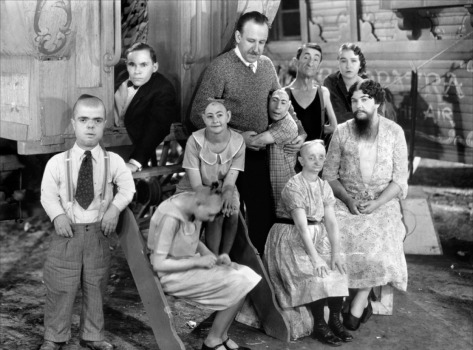On what was my busiest day of the festival thus far, my film experiences yesterday ran the gamut of human emotion. From the laughs and tears of City Lights to the nostalgia of I Remember Mama, to delight at the naughtiness of The Women to the uncomfortable but ultimately triumphant horror of Freaks. It was quite a long day and so, dear readers, I was compelled to begin writing this post on the morning of the last day of the festival, in the name of sleep and sanity.

The first film of the day yesterday was City Lights, a 1931 Charlie Chaplin masterpiece that is one of his many tours-de-force and happens to be one of my personal favorites of all time. It tells the story of a blind girl who is befriended by Chaplin’s “little tramp” character, and when she is unable to afford her rent, he goes through a series of precarious (and often hilarious) circumstances to get the money for her. The movie is laugh-out-loud funny, but with a certain poignancy in Chaplin’s scenes with the blind girl, a poignancy that serves to give the tramp character his humanity. This is typical of Chaplin–right when we are about to write the tramp off as nothing but a silly clown, we are shown a side of him that is so sweet, gentle, and kind, we cannot help but relate to him in some way and think of him on our own human terms.
The ending of City Lights is, in my opinion, one of the most beautiful endings ever in the history of the movies. For those of you who have not seen it and prefer not to have the ending spoiled, skip this paragraph and clip! But for those of you who don’t mind spoilers, I will show you an ending that is sure to melt the coldest of hearts. When the tramp is with the blind girl at one point in the movie, she discusses the possibility of surgery on her eyes so that she may see. It is inferred that with the money that the tramp gives her for her rent (he manages to get her a lot more than her rent required, by enlisting the help of a millionaire friend who, through a series of circumstances, ends up not remembering him and the tramp is thrown in jail for extortion), she is able to afford the operation, but as the police believe that the tramp stole the money, he ends up in jail and unable to see the girl until he is out. Autumn comes, and the tramp is out of jail…disheveled with raggedy clothes on, he sees the girl, who has had her operation. This is the scene:
Needless to say, it was an emotional moment in the theater. It is rare that a movie can make you laugh so hard, and then tug at your heartstrings with such grace and beauty.

Next up was I Remember Mama, a glimpse into the life of a Norwegian immigrant family in San Francisco in the early 1900s. The plot is simple–a young woman recounts her childhood in flashback, recalling the days with her family, the good times and the bad times. TCM’s theme this year is “Family: The Ties That Bind,” and they couldn’t have picked a more appropriate addition to the festival than I Remember Mama. The film earned Irene Dunne her final Academy Award nomination, and in my personal opinion she was robbed that year. Though the competition was tough–she was up against Olivia de Havilland for The Snake Pit, Barbara Stanwyck for Sorry, Wrong Number, Ingrid Bergman for Joan of Arc, and the ultimate winner, Jane Wyman in Johnny Belinda–Irene Dunne’s performance as the devoted Norwegian mother is flawless. She speaks with a convincing Norwegian accent, and in one scene in which she has to leave her child alone in a hospital, you can feel her pain and guilt. It is a remarkable movie, and a love poem to mothers everywhere.

Maureen O’Hara and Walter Pidgeon in HOW GREEN WAS MY VALLEY (1941)
I was concerned about getting into the next movie, as there would be a special guest–and not just any special guest. The legendary Maureen O’Hara was slated to appear at the screening of How Green Was My Valley, and as I expected, the line was the longest I had ever seen at this festival. I did end up getting in, and they showed a beautiful montage of clips from Maureen O’Hara movies before Maureen came out–teary-eyed with emotion. At 93 years old she is still strikingly beautiful, and speaks elegantly with a touch of an Irish brogue that came and went during her film career but now seems here to stay. I had the great privilege of meeting Maureen O’Hara several years ago when I was in Ireland, and she is truly a larger-than-life personality. A great lady with great convictions that are apparent whenever she speaks.
How Green Was My Valley is a touching coming-of-age story set in a Welsh mining town, and Maureen O’Hara plays Angharad, sister of main character Huw (Roddy McDowall). The film makes a great many points about family and fairness, especially in regard to labor and treatment of others. It is a simple film that doesn’t put on any airs, yet it won the Academy Award for Best Picture in 1942–winning over Citizen Kane.
The next activity was a showing of several Hollywood home movies from the Academy Film Archive, including home movies from the Ziegfeld family, footage from Hearst Castle, the set of Oklahoma, and rare backstage footage of a young Jean Harlow. Accompanied by a live piano, the silent clips were shown with live commentary from special TCM guests, including, notably, the great-granddaughter of Florenz Ziegfeld and Billie Burke.The Academy Film Archive is a treasure trove of films, newsreels and film clips, and their selections for the festival are always fascinating. This is becoming a yearly event at the TCM Classic Film Festival, and I always make it a point to go. The audience was enraptured and enthusiastic, and it was great fun to experience.
After having coffee with fellow blogger Vincent Paterno, who is in town for the festival, I headed off to see The Women, a movie readers of Backlots are quite familiar with by now as I have written about various facets of the movie on many different occasions. It is one of the smartest, wittiest movies of the 1930s and, I would argue, of all time. Yesterday’s screening featured a talk with Anna Kendrick, Oscar-nominated actress who happens to be a huge fan of The Women. Kendrick spoke intelligently and passionately about this movie, and she and Ben Mankiewicz (who interviewed her) clearly have a great rapport. It was a lot of fun, and the talk went overtime because Kendrick had so much to say.
I won’t delve into the movie in this write-up, as I would be writing about it all day and you can read my varied analyses of this movie here, here, and here, but suffice it to say that it’s one of my favorite films to discuss. I am especially fascinated by the the influence that designer Elsa Schiaparelli had on the film’s costume designer, Adrian, evidenced in the fashion sequence and throughout the movie.
My final viewing of the night was a midnight showing of Freaks, a dark look into the world of circus sideshows that ultimately brings light to the way people with disabilities were treated within the confines of so-called “freak shows.” It is a movie whose concept makes a lot of people uncomfortable, and I think it’s partly because there is a misunderstanding of the film’s title from those who have not seen the movie. It is often passed over by people who are either offended by what they assume the movie will be, or by those who fear the dark and bizarre subject matter. But at its core, Freaks is a movie that turns stereotypes upside down. Previously (and since), actors who had some sort of physical disability were often cast as villains or characters to be feared. In Freaks, it is the disabled characters who are the “good guys,” and the able-bodied characters are the ones to be feared. It is quite an unusual and progressive scenario. Tod Browning spent much of his life working in circuses, and knew this world very well, which makes his interpretation all that more fascinating. In addition, nearly all of the characters were portrayed accurately, by disabled actors or real life sideshow performers.

Tod Browning with some of the cast members of FREAKS (1932).
Today, as the last day of the festival, is a bit of a lighter day, but there are some good things on the horizon to look out for tomorrow! See you then!




























_03.jpg)

